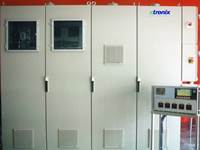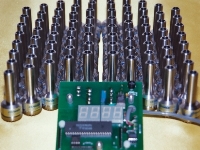- Cryogenics
- General thermodynamics
- MEMS technology
- Mechanical engineering
- Electronics
- Software development
- Superconducting devices (including SQUIDs)
- Microfluidics
- Thin film technology
xtronix custom designs removes the burdensome task of design engineering, parts procurement, assembly, testing and final qualification. We work with suppliers, often companies we actively distribute products of, to obtain the best price and delivery, leaving our customers more time to focus on their own clients and less time worrying about all the intricacies of custom designs.
Further, with its global resources and cutting edge know-how, xtronix is often times able to procure custom sub-parts in small quantities.
There have been many instances in the past where we undertook custom designs for our clients. These have varied from special vacuum components as feedthrough assemblies for radar or night vision devices to Pirani vacuum gauges, sputter coater and gas blender, or to yet the VES-210 described below.
The VES-210 is a 'customizable' production vacuum exhaust station consisting of 2x10 vacuum evacuation and gas backfill ports; 10 in each heat zone. The ports can be batch pumped (so either 10 or 20 ports can be pumped simultaneously) yet can be isolated individually by toggle valves.
The design can be used for production of gas-backfilled devices typically as used in X-ray collection techniques such as X-ray Fluorescence / Diffraction products, or in the manufacture of appendage ion pumps, small communication oscillation devices or other pinch-off cavities.
High vacuum is achieved by a turbo-molecular pump. The vacuum cycle is fully automated via a miniature programmable logic controller (PLC). Vacuum and gas hardware is stainless steel throughout and the vacuum hardware is mostly right out of our own 88-page vacuum components catalog. The system conforms to CE norms.
A high-precision absolute pressure sensor is used for the backfilling pressure (accuracy: 0.05% of reading; resulting accuracy of 0.5 mbar @ 1000 mbar). The sensors for rough and high vacuum are a broad-range xtronix iridium filament Bayard-Alpert and two thermocouple gauges.

This multi-gas blender was ordered by the European Space Agency (Holland) under a research project involving a team of scientists at the University of Bern, Switzerland.

These rough vacuum gauges were produced for an International manufacturer of high value analytical equipment. Two orders totalling 350 units were delivered to the OEM.

This production vacuum exhaust and gas backfill station was conceived for an American hi-tech manufacturer of advanced equipment and installed in their Swiss production unit.
In accelerator physics, beamline refers to the particle trajectory along a specific path of an accelerator facility. Beamlines usually end in experimental stations that utilize particle beams or synchrotron light, or neutrons from a spallation source or research reactor. If you need to cool a sample within the beamline, it can get complicated. Since in practice there often are no off-the-shelf cryogenic solutions for beamlines, in partnership with Kryoz Technologies Holland we use a product development work-flow that has proven to be reliable and results in a very high chance of success. In summary this means that the development is divided in small sub-projects, where the client has the possibility to define go-no-go milestones after every sub-project or even work package. This way all the steps from basic idea to fully functional product can be controlled in great detail.

A typical custom product development includes, but is not restricted to, the following steps:
Key Features |
Our fields of expertise |
|
|